Pushing Boundaries at Kappou Gomi (SF)
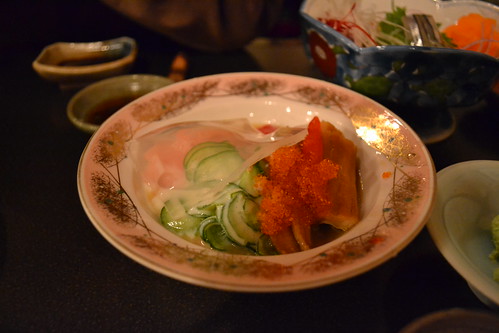
"Where the hell are we? Did we miss it?" I ask as we drive further and further away from the city center. Geary Boulevard is still bustling, but we're way past Japantown now, and the storefront signs are getting harder to read. Besides, why would a restaurant like Kappou Gomi be all the way out here?
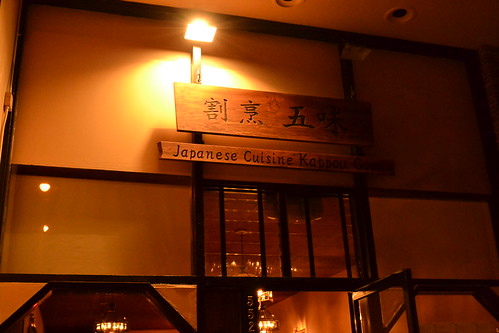
Yup, Kappou Gomi is in the Outer Richmond, an area that some cityfolk would consider as the "suburbs of San Francisco". You won't find any sushi here, which they wear as a badge of pride. Instead, Kappou Gomi offers a massive menu selection of small plates that all work together to complete an entire meal.
This notion of "Japanese small plates" does not denote that this is an "izakaya". As Yoko and Washi mentioned in this SF Weekly post (they are a Bay Area Power Couple now, holla!) a kappou-style restaurant is a step above the more casual, drink/nibble/dash type of izakaya.
In speaking with Cupertino's Sushi Kuni owner/chef Kunio (aka Father), the word kappou is actually used to describe stewed or braised dishes, which are considered the "main dish", or the meal's centerpiece in Japan. This, he says, is the most revered art of cookery, as making nimono (stewed vegetables and/or meats) or nitsuke (stewed fish) are the most difficult dishes to master. [While Kuni is a classically trained chef from Japan, I will always say that Hideko is the better overall cook, as her nimono blows his dishes out of the water]. Kuni says that in Japan, the most highest-ranking chef of a restaurant would be in charge of the kappou dishes.
That said, kappou has now evolved into a style of restaurant. A step above an izakaya, a "kappou restaurant" would still be small and intimate, but Kuni (and Washi) said more expensive and formal, as the dishes involve more technique than in an izakaya.
We walked in on a busy Sunday night, and we longingly waited for our table for 20+ minutes. Tables for two, four, and six scatter the restaurant and there is a bar area in the back as well. Older ladies rushed around in typical frock-like aprons, taking everyone's order while a younger, tall gentleman walked around serving tea and impressively stacking a gajillion plates onto one arm. Framed drawings and artwork sparsely decorate the walls, but besides the bizarrely opulent light fixtures hanging overhead, the interior is modern (more so than the usual mom-and-pop Japanese restaurant) but not gaudy.
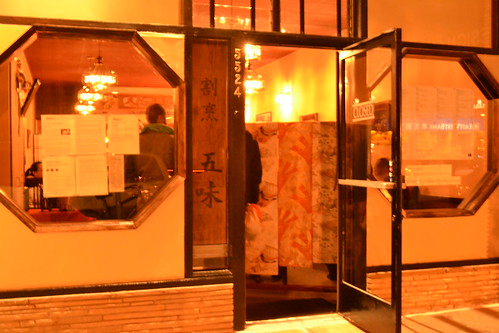
The menu at Kappou Gomi is dense and requires complete concentration. Don't talk while I'm studying this please! Seriously, the pages of dishes are never ending, each section categorized by a particular meat or fish, then several different kinds of preperations under that. I wish I took a picture of this heavy, beautifully bound menu.
Then, of course, there's the days special menu (本日のおすすめ; honjitsu no osususume aka today's recommendations). ALWAYS order from this menu, especially if you want what is in season or would just rather avoid the bible-like regular menu.
As you do at these sort of "smaller plate" Japanese restaurants, order a few dishes at a time and enjoy your drinks. No need to rush! Luckily, there were four of us, so we were able to try many dishes.
Kibinago sashimi (a species of herring):
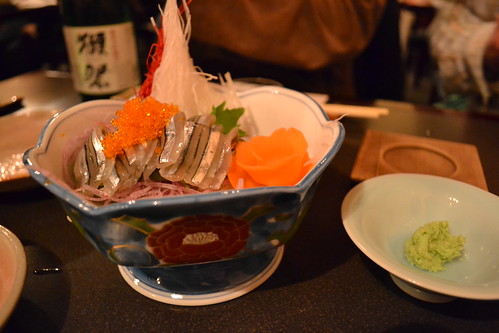
This was on the special menu, and were gorgeous, nicely sliced, with some tobiko (flying fish eggs) on top for extra POP! I had never had kibinago before--it tasted very fresh, and considering it is herring, it was not so overpoweringly "fishy".
We had ordered a bottle of Dassai 50 sake, served cold. You can see it in the background in the above picture. It is a junmai ginjo, and one of Washi's favorite breweries (Washi is the bartender at Ippuku in Berkeley). The sake tastes exceptionally clean, and complimented these colder dishes well. Watch Urban Sake's video review here.
Housemade kamaboko (fish cake) with freshly grated wasabi:
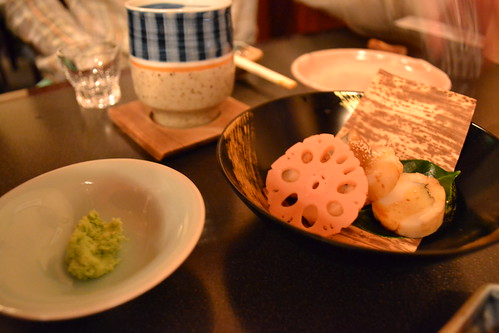
As I've mentioned before, I'm a huge fan of kamaboko. I believe this was made of tai (red snapper), with a little bit of roe and sweet sauce drizzled on top and renkon (lotus root) for garnish.
Hirame no usuzukuri (flounder sashimi, usukukuri-style):
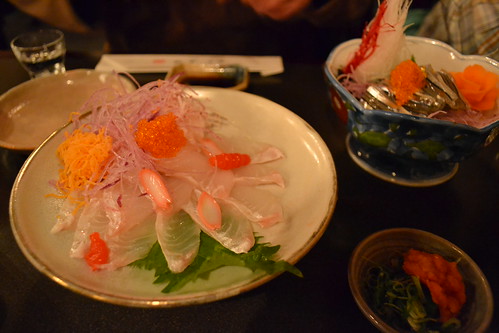
This dish is one of my all-time favorites. Thinly sliced hirame with ponzu, scallions and spicy grated radish for dipping. This takes a lot of technique, as the fish must be sliced paper thin (the "usu(i)" of usuzukuri means "thin"). Although they look translucent here, these were still sliced a bit too thick. Kuni creates a beautiful version with I will post sometime.
Anago no sunomono (Sea eel with cucumber and wakame salad in vinegar sauce):

A thin slice of kanten (sea kelp gelatin) was placed on top of the dish. Nice touch!
Let's take a moment to meditate on the actual dishes themselves. Look at the one above with the pastel pink rim and gold etchings and whimsical brushstrokes. All of these dishes were gorgeous, and nothing we ordered came in the same bowl or plate. They all seemed to be hand-picked from Japan and each had its own purpose to create warmth throughout the table. Check out the variations of plates, in sizes, shapes and color!
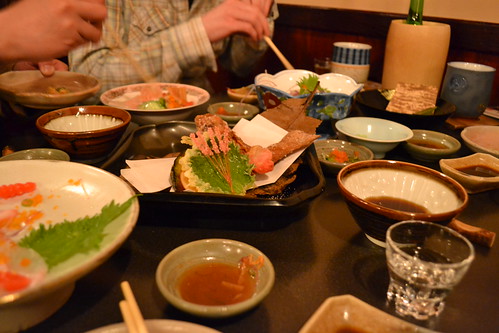
Dishware in Japanese cuisine is extremely important, as aesthetics and presentation play such a huge role in each dish, especially in more upscale restaurants in Japan. My mom Hideko will only bust out her prized Japanese ceramic dishware for special occasions, so this felt really fancy. (I am slowly stealing Hideko's plates for my own home, one by one. Shhhhhh).
Karei no karaage (fried flounder):
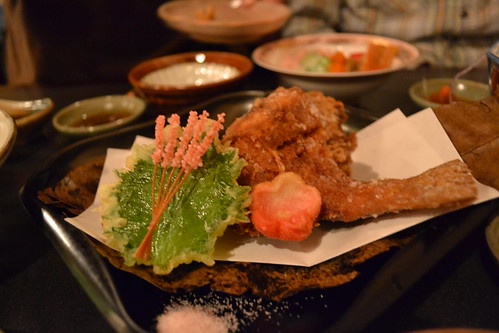
Also one of my favorite dishes, this is flounder battered with cornstarch and fried. Dip in ponzu, or sprinkle salt.
Ebi no koromo-age (various fried shrimp):
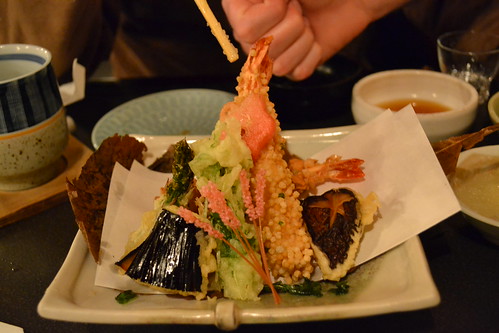
Kuni says that the term koromo-age is a style of frying where you add an extra ingredient to the batter. Here, the chef prepared the shrimp in three ways: one shrimp with almonds, another with peanuts, and one more with tiny balls of senbei (rice crackers). These were absolutely fantastic. Perfectly crisp on the outside, with added texture and crunch from the nuts or senbei, while the actual shrimp was practically raw. This takes a ton of technique and I tip my hat to them.
To round out the meal, we ordered yu-dofu, which is simply tofu in a warm dashi broth. I don't have a picture, but this was also a highlight of the meal, and is optimal on a cold night. We would have ordered some soba, or something stewed and more substantial, but we did as Tokyo-ites d0 and went for Round Two at a ramen joint instead. It's the good life.
Kappou Gomi is a destination restaurant that is definitely worth the excursion. This location choice, I have to say, is quite a gamble for Kappou Gomi, given that the restaurant is really pushing the limits of what Americans would consider "authentic Japanese food" to be.
It will certainly take a number of visits to Kappou Gomi to try all of their dishes, and I definitely plan to do so. Go with many people, and always plan to share.
*Photos by Yoko Kumano.
**Our thoughts are with Japan, our families and friends, and all victims of yesterday's horrendous earthquake. Battle Sendai. Push through.
